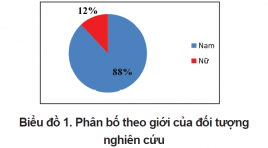
ĐẶC ĐIỂM HÌNH ẢNH VÀ KẾT QUẢ ĐIỀU TRỊ NÚT MẠCH HÓA CHẤT UNG THƯ BIỂU MÔ TẾ BÀO GAN Ở BỆNH NHÂN DƯỚI 40 TUỔI
16/11/2021 11:24:31 | 0 binh luận
SUMMARY Objectives: Describe the characteristics of ultrasound images, computed tomography, angiography and results of chemoembolization in patients with HCC under 40 years old at the Radiology Center of Bach Mai Hospital. Methods: A cross-sectional study was carried out on 25 patients with a confirmed HCC who treated chemoembolization at the Radiology Center - Bach Mai Hospital from August 2018 to August 2021. Results: On 2-dimensional ultrasound, the majority of HCC tumors had hypoechoic and mixed sound images (72%) and increased angiogenesis on color Doppler ultrasound, reaching 68.0%. On computed tomography images, tumor density decreased 64% and increased angiogenesis 68.0%. Tumors of HCC have increased angiogenesis on angiography, reaching 92%. After treatment AFP tends to decrease in the first 6 months, then increase in the 9th month. Bilirubin tends to decrease in the first 3 months, then increase at 6 and 9 months. Tumor size tends to decrease at 1, 3 and increase at 6, 9 months. Median survival was 13 months with interquartile range [5.5 ÷ 22], the longest survival time with continued follow-up was 57 months. Conclusion: Chemoembolization therapy is effective in reducing tumor size, bilirubin, AFP and prolonging survival time for patients under 40 years old with HCC. Keywords: chemoembolization therapy, hepatocellular carcinoma
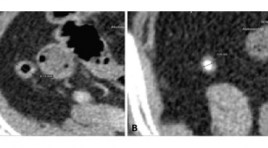
ĐẶC ĐIỂM HÌNH ẢNH RUỘT THỪA BÌNH THƯỜNG TRÊN CẮT LỚP VI TÍNH BỤNG
15/11/2021 17:27:02 | 0 binh luận
SUMMARY Aims: To describe the morphology of normal appendix on abdominal contrast-enhanced computed tomography (CECT). Materials and methods: A cross-sectional study was conducted on all patients ≥ 18 years who underwent abdominal CECT for various indications from 04/2019 to 07/2020. Exclusion criteria include previous history of appendiceal diseases, appendicectomy, clinical manifestations suspected appendicitis, and other gastrointestinal-related comorbidities. All appendiceal morphology (length, diameter, wall thickness, intraluminal contents, location of base and tip) were documented. Results: 186 patients (54.8% male) with the mean age of 51.6 ± 13.4 years were enrolled in the analysis. The mean maximal diameter, mean length and mean wall thickness of the appendices were 6.7 ± 1.3 (range, 3.6 – 11.7 mm), 82.1 ± 24.8 (range, 20.5 – 138.2 mm) and 2.1 ± 0.4, respectively. The mean diameter measured on axial view was significantly lower than that of on coronal view (p <0.05). Appendicoliths were identified in 5.9% of cases. The most common locations of the appendiceal tip were subcecal and retrocecal (22.6% each). Conclusion: A new threshold should be proposed, clinical manifestations and multi morphological factors correlation are strongly recommended when diagnosing appendicitis on CECT. Normal appendices can contain air, fluid and appendicolith with an incidence that varies among individuals. Keywords: normal appendix, computed tomography, appendix location.
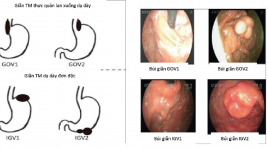
NÚT BÚI GIÃN TĨNH MẠCH DẠ DÀY XUÔI DÒNG QUA DA Ở BỆNH NHÂN TĂNG ÁP LỰC TĨNH MẠCH CỬA DO XƠ GAN
15/11/2021 16:56:32 | 0 binh luận
SUMMARY Abstract: Gastrointestinal bleeding due to rupture of esophageal varices and gastric varices in cirrhosis is quite common and has a high mortality rate if untreated. Gastric varices are difficult to control under endoscopy, intravascular intervention is a highly effective method. In patients who don't have or an inappropriate gastrorenal shunt, antegrade transvenous obliteration method is the preferred method of treatment. Purpose: To evaluate the initial results in antegrade transvenous obliteration method in cirrhotic patients with gastric varices. Material and methods: 13 patients diagnosed with cirrhosis of the liver had gastric varices from June 2020 to June 2021 received an antegrade transvenous obliteration intervention. The varices were assessed by endoscopy and MSCT before treatment, immediate effect after intervention on DSA imaging and clinical improvement. Results: 13 cirrhosis patients with gastric varices performed antegrade transvenous obliteration, of which 3 patients were treated with a combination of both PARTO and ATO. Results 12/13 patients were occluded from all branches, there was no case of acute gastrointestinal bleeding within 3 days after intervention account for 92,31%. 1/12 patients with complete occlusion of the feeding branches had recurrent gastrointestinal bleeding during the follow-up period > 3 months account for 8,33%. There were 3 patients who went to the examination again after 3 months, endoscopy or MSCT scan showed reduction of phlegmon dilated, no gastrointestinal bleeding. Conclusion: antegrade transvenous obliteration intervention is an effective method in patients with gastric varices rupture but without gastrorenal shunt or modified gastrorenal shunt cannot perform simple PARTO method. Keyword: Gastric varices, antegrade transvenous obliteration, retrograde transvenous obliteration, gastrorenal shunt

Đặc điểm hình ảnh ung thư thực quản trên cắt lớp vi tính 256 dãy
06/05/2021 17:30:13 | 0 binh luận
SUMMARY Purpose : Describer the imaging characteristics of esophageal cancer on MDCT 256-detector row. Material and method : From June 2019 to June 2020, 32 patients with esophageal cancer were treated at Huu nghi Hospital. The quantitative parameters were expressed as mean and standard deviation while the qualitative parameters were expressed as percentage. SPSS 26.0 was applied. Results: 3.1.% cases were not found on MDCT. The tumors were found most commonly in the middle and low one third. The tumor size were 44.8±33.01 mm of length and 12.2±4.77 mm of thickness. All of them were T3 stages. 48.4% patients have lymph nodes. Majority of lymph nodes were in mediastinum or supraclavicular areas. 9.6% patients were metastasized. Conclusion: MDCT 256-detector row is helpful for characterising esophageal cancer. Key words: esophageal cancer, computed tomography, staging.

Vai trò của chụp cắt lớp vi tính 128 dãy trong đánh giá giải phẫu động - tĩnh mạch đoạn ngoài thận ở người cho sống
06/05/2021 16:27:48 | 0 binh luận
SUMMARY Objective: The purpose of this study was to determinate the accuracy of multidetector computed tomography (MDCT) angiography for imaging evaluation of renal arterial and venous structures of living donor kidney Materials and Methods: Two hundred twenty-eight potential living donor candidates were included to this study, who had CTA for the assessment of their renal vessels in our hospital between January 2018 and June 2020 and one hundred-eighty donors who underwent open surgical in this time. The number, course, and drainage patterns of the renal vessel were retrospectively observed from the scans. Anomalies of renal arteries, veins and inferior vena cava (IVC) were recorded. Multiplanar reformations (MPRs), maximum intensity projections, and volume rendering were used for analysis. The results obtained were correlated surgically. Results: A total of 228 potential live kidney donors underwent renal CTA (112 of the patients were male, and 116 were female. Mean age of donors was 38,32 ± 12,34 years. among them 180 patients had donor nephrectomy. There were 151 kidneys had single renal artery , here were 29 kidneys had at least one accessory or polar artery. There were 45 early branching renal arteries, two kidneys were retroaortic left renal veins. 16 kidneys had multiple renal veins. 55 kidneys wewe late venous confluence of renal veins. Sn, Sp, NPV, PPV compare open oparative nephrectomy 87,5%- 100%. Conclusion: Renal CTA is an accurate, safe and noninvasive diagnostic tool for determination of renal artery and vein abnormalities in living kidney donors preooparative. It helps with surgery planning, choosing operation side and exclusion of donors. Keyword: CTA, MSCT, living donor
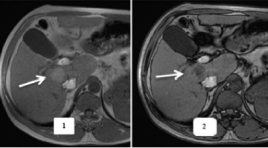
Nghiên cứu giá trị của cộng hưởng từ với thuốc đối quang từ primovist trong chẩn đoán ung thư biểu mô tế bào gan
06/05/2021 14:48:38 | 0 binh luận
SUMMARY Aim: Evaluate the value of MRI with Gd-EOB-DTPA (Primovist) in the detection of HCC comparison with the pathological results Methods : Descriptive cross-sectional research, performed on 28 patients consist of 2 groups: Group I includes 18 patients with HCC and group II includes 10 non-HCC patients (7 patients with focal nodular hyperplasia. 3 patients with liver metastasis). The patients whose liver lesion were detected on diagnostic imaging modalities undergone MRI with hepatiobillial specific contrast agent Gd-EOB-DTPA (Primovist). Thereafter, definite diagnosis was based on histopathological results of biopsy or surgery. Results: Hepatobiillial phase hypointense was the most sensitive diagnostic criteria of HCC(94.4%), however, specificity is only 70%. For liver cancer diagnosing, arterial enhancement followed by washout on portal venous or late phase had the sensitivity, negative predictive value and diagnostic accuracy were 61.1%, 58.8% and 75%, respectively. When combining with hepatobillial phase hypointense, these values increased to 72.2%, 67.7%, and 82.1%, respectively; while, the specificity and positive predictive values were unchanged. Conclusion: Hepatobiillial phase hypointense is a good diagnostic criteria on detection of HCC than differential diagnosis with other hepatic lesions. The addition of hepatobiillial phase on MRI with Gd-EOB-DTPA (Primovist) increases the likelihood of detecting HCC lesions.
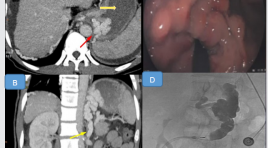
Nghiên cứu đặc điểm búi giãn tĩnh mạch dạ dày ở bệnh nhân xơ gan trên hình ảnh cắt lớp vi tính đa dãy để chỉ định can thiệp PARTO
06/05/2021 12:58:38 | 0 binh luận
SUMMARY Esophageal varicose veins are the main cause of high GI bleeding in cirrhotic patients. Plug – assisted retrograde transvenous obliteration (PARTO) is a safe, minimally invasive, effective hemostasis technique and prevent recurrence in gastric variceal hemorrhage/ gastric varices that has been widely deployed in many countries such as Japan and Korea. Multislice Computer Tomography (MSCT) that provides complete information about the features of gastric varicose buns is the method that should be performed prior to PARTO intervention. Objectives: 1. Characterization of gastric varicose buns on multiseries computed tomography and Kiyosue classification. 2. Comparing multi-sequence computed tomography with DSA image of gastric varicose tufts in patients with PARTO retrograde intervention. Methods : The study was conducted retrospectively and with crosssectional descriptions of 91 patients with cirrhosis and gastric varices admitted to the hospital because of gastrointestinal bleeding were taken MSCT in the period from April 2018 to July 2020. Conclusion : Among 91 cases of gastric varices; the majority of gastric veins dilated to an average of 5-10 mm (51 patients), supplied mainly from the left gastric vein (84 patients) and drained to the esophageal veins (60 patients). The diameter of the dilated gastric vein measured on the MSCT was correlated with the number of afferent portal venous feeders and not with the number of efferent systemic venous drainage. The major gastric varicose tufts fall under the type 2B classification (~ 22%). Out of 91 cases, there were 58 cases with gastrorenal shunt, 2 cases with gastrocaval shunt, of which 21 cases of severe gastrointestinal bleeding required PARTO intervention; There were 2 cases where there was no renal shunt but had severe gastrointestinal bleeding, PVTO. For the PARTO intervention group, the renal shunt diameter measured on CLVT and measured on the DSA did not differ with p = 0.083. Results: The gastric varicose buns is mainly supplied with blood from the left gastric vein, and drained by the esophageal vein and the kidney shunt. Examination of imaging of gastric varicose buns is necessary to determine whether PARTO is indicated, to select the right materials and to effectively predict of PARTO interventions. Keywords: xơ gan, giãn tĩnh mạch dạ dày, can thiệp ngược dòng qua shunt vị thận bằng dù /cirrhosis, gastric varices, Plug – assisted retrograde transvenous obliteration.
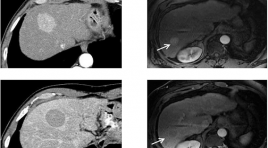
Cập nhật phân loại u gan theo LI-RADS 2017
05/12/2019 11:07:09 | 0 binh luận
LI-RADS thường được áp dụng ở những bệnh nhân có yếu tố nguy cơ cao HCC gồm: Xơ gan hoặcViêm gan B mạn tính hoặc đã/đang bị HCC.
Bạn Đọc Quan tâm
Sự kiện sắp diễn ra
Thông tin đào tạo
- Những cạm bẫy trong CĐHA vú và vai trò của trí tuệ nhân tạo
- Hội thảo trực tuyến "Cắt lớp vi tính đếm Photon: từ lý thuyết tới thực tiễn lâm sàng”
- CHƯƠNG TRÌNH ĐÀO TẠO LIÊN TỤC VỀ HÌNH ẢNH HỌC THẦN KINH: BÀI 3: U não trong trục
- Danh sách học viên đạt chứng chỉ CME khóa học "Cập nhật RSNA 2021: Công nghệ mới trong Kỷ nguyên mới"
- Danh sách học viên đạt chứng chỉ CME khóa học "Đánh giá chức năng thất phải trên siêu âm đánh dấu mô cơ tim"












